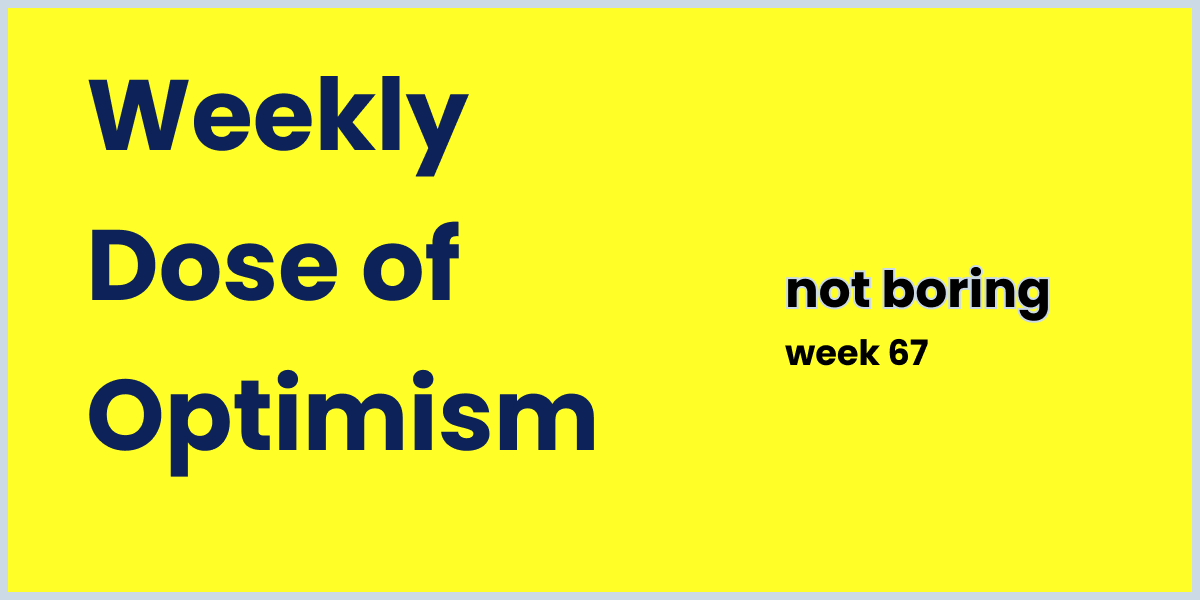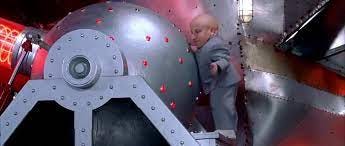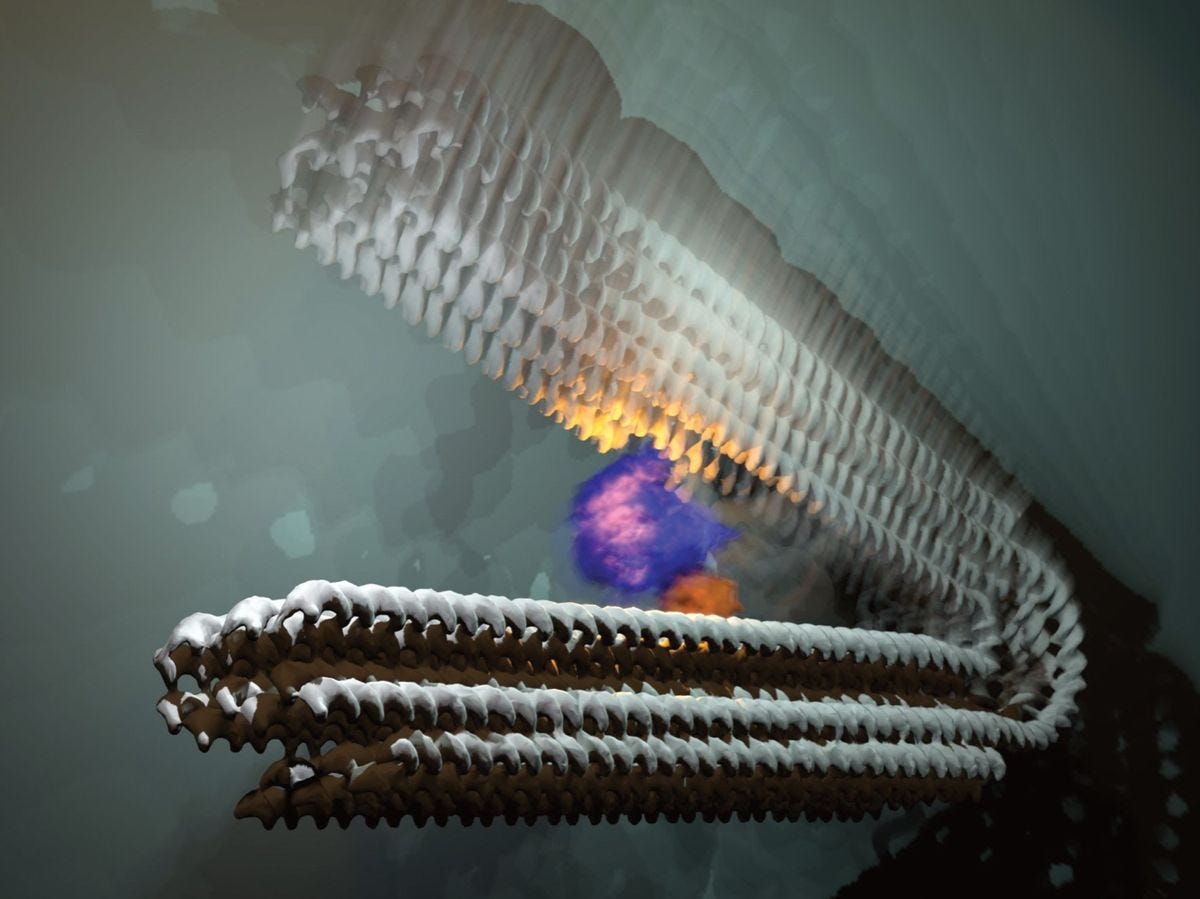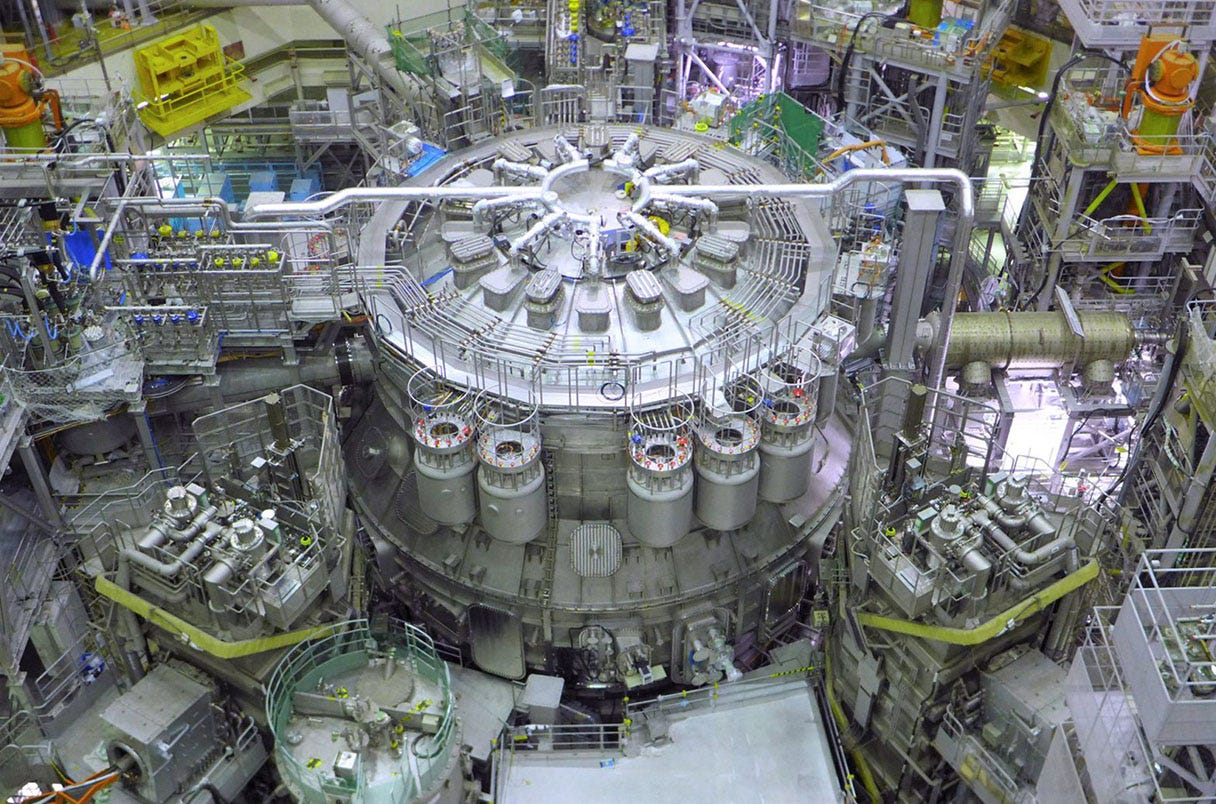Not Boring by Packy McCormick - Weekly Dose of Optimism
Hi friends 👋, Happy Friday and welcome back to our 67th Weekly Dose of Optimism. It’s a big weekend here in NYC — Marathon weekend. I like to think of marathons as optimistic endeavors — displaying human potential, our ability to overcome obstacles, and to delay instant gratification in favor of longer-term personal growth. You don’t meet too many pessimistic marathon runners. Good luck to all runners this weekend, with a special s/o to my girlfriend Sienna ❤️. Let’s get to it. Today’s Not Boring is brought to you by… Age of Miracles  Packy here. Instead of a sponsor, I’m going to pump our new podcast: Age of Miracles. Our first season is on nuclear energy, and the combination of innovation and nitty gritty it’s going to take to build an energy abundant future. We just released Episode 3 minutes ago. You can listen to it on Apple, Spotify, or wherever you listen to podcasts, or watch it on YouTube. Thanks to all of you who listened, commented, liked, subscribed, reviewed, shared, and gave us feedback on our first two episodes! We climbed as high as #12 on the top tech podcast charts, which beat my expectations for Week 1. Let’s keep it going and break the top 10. Episode three is all about what it’s going to take to build more large reactors more affordably and predictably. We cover how nuclear plants work, their economics, why their Idiot Index is so high, and the steps we might take to improve their economics. We cover everything from cost overrun insurance to psyops, debate whether government or the free market has a bigger role to play, and try to answer the question of what it would take to bring large nuclear plants down the experience curve. For those who want to go deeper, we put together a Nuclear Resource Guide that we’re updating each episode, with links to articles, podcasts, videos, and more. I want to give a big shoutout and congrats to my co-host, Julia DeWahl. The company she co-founded, Antares, came out of stealth and announced an $8 million seed this week. Their vision: abundant clean energy for all, from earth to the asteroid belt. You’ll hear a little more about what they’re building on Episode 5. Harry Baker for Space.com
OK, you probably didn’t expect Mini-Me humping a laser to start off the newsletter, but let me explain…Scientists have activated the world's smallest particle accelerator, a nanophotonic electron accelerator (NEA), which is the size of a coin and accelerates electrons using mini laser beams aimed at "pillars" within a microchip. Anytime I hear mini and lasers in the same sentence, my mind goes to the image above…sue me. The NEA is 54 million time smaller than the 16.8-mile-long Large Hadron Collider at CERN. It fits within a microchip and boasts a main acceleration tube only 0.02 inches long. The NEA has wide range of potential applications, including putting particle accelerators inside human patients. For example, a tiny NEA could be placed on an endoscope to better administer precise radiotherapy for cancer patients. That’s the main goal of the research, but who knows what else those crazy scientists will dream up once we have the ability to put particle accelerators inside of humans. Accelerate, indeed. (2) This Pulsing DNA Nanomotor Can Power Molecular Machines Prachi Patel for IEEE Spectrum
Speaking of tiny machines inside of our body… an international team of researchers have developed a DNA nanoengine that can perform pulsing movements, driving nanomaters with chemical energy instead of random Brownian motion. It’s an example of DNA origami, which “involves carefully designing DNA sequences that can fold, twist, and staple together at the right places to assemble into preconceived structures.” On Tuesday, Elliot took us on a tour of the mindblowing world of cell-based therapy. He wrote about “engineering a patient’s own immune cells to cure cancer, reprogramming cells and tissues to a younger and healthier state as we age, designing bacteria in our gut to pump out GLP-1 molecules when we eat too much, and curing diabetes with a single infusion of cells instead of countless infusions of insulin.” DNA nanomachines are another avenue for making changes inside our body, and in the physical world. The researchers think that their pulsing nanometer should be easy to connect to other tiny molecular machines, driving them as they construct medicines and electronics. DNA origami nanoengines that can make things … what a world. (3) First plasma fired up at world’s largest fusion reactor Dennis Normile for Science
Big things are happening at much larger scales, too. We’re one small step closer to commercial fusion. Japan's JT-60SA, the world's largest fusion reactor, turned on last week. This machine can sustain a plasma heated to 200 million degrees Celsius for about 100 seconds, surpassing prior large tokamaks. The activation demonstrates the reactor's foundational functionality, though it will take another couple of years before the JT-60SA can sustain plasmas long enough for use in meaningful physics experiments. That said, the success of and learnings from JT-60SA will bolster the progress of ITER, the world's largest and most advanced experimental tokamak reactor. The main goal of ITER is to demonstrate the feasibility of large scale fusion. While ITER is based in France, it’s one of the largest international scientific collaborations in history, with over 35 countries involved, including the US, China, and Russia. Both ITER and JT-60SA have been slow — with such advanced, complex, and enormous machines, there are bound to be issues and delays — and we’re excited by the startups entering the Fusion Race to speed things up. But fusion is a great demonstration of the interplay between government, academia, and startups, across the world, working together to unlock abundant energy for all of humanity. The more that reactors like JT-60SA push progress and knowledge forward, the faster others in the space can move, and the closer we get to generating power the same way the sun does. (4) Regulating AI by Executive Order is the Real AI Risk Steven Sinofsky for Hardcore Engineering
On Monday, The White House issued an Executive Order on the Safe, Secure, and Trustworthy Development and Use of Artificial Intelligence. It’s still TBD how the EO will play out in practice, but it is clear that the Federal Government is paying more attention to AI and that tighter regulation will likely follow. What would be a win for the leading AI companies of today — whatever risk-mitigating regulation that flows from this EO will likely only go to further entrenched companies like Microsoft, Google, and OpenAI, and stifle innovation and ambition from current and future AI startups. That’s the argument Ben Thompson makes in the most fiery Stratechery piece we’ve read in a long time: Attenuating Innovation:
Steven Sinofsky, a former president of the Windows Division at Microsoft and current Board Partner at a16z, predicts a similar outcome in the essay linked above. The main point of Sinofsky’s essay is that this EO seems to be coming from a place of fear and pessimism — if you think that AI is going to destroy the world, you’d try to regulate it — rather than a place of optimism. Pessimism, in this case, will ultimately lead to regulatory capture and stifled innovation. Optimistic law making would promote research, competition, and experimentation to push U.S.-based companies to the frontier of A.I. and ensure the nation is at the cutting edge of this technological wave. Optimism (and pessimism) shape reality. This is a prime example of that. Once a regulation is in place, it’s incredibly hard to roll it back. Thankfully, this is just an Executive Order, but it should be a warning shot that we’re going to put rules in place now that could impact humanity for decades to come. It’s worth reading both Sinofsky and Thompson’s pieces to get up to speed and fight on the side of the optimists. (5) Palmer Luckey - Inventing the Future of Defense
Packy here. If there’s anybody who has hands-on experience actually putting AI in weapons systems, it’s Palmer Luckey, the founder of Oculus and Anduril. And Palmer thinks AGI, if we achieve it, will be more useful on defense than offense.
That’s just one of the many gems in Palmer’s conversation with Patrick O’Shaughnessy on Invest Like the Best. In recent years, he’s used the podcast circuit to go scorched-earth on the investors, partners, and journalists that he believes mistreated him earlier in his career. You should go find those podcasts, like this appearance at the All-In Summit, because they are both entertaining and eye-opening as to how tech media operates. This conversation was much different. In this one, Palmer describes his motivations for doing what we he does: to make the world a different place. He wants to make it better, certainly, but above all else, he wants to make a big impact. And to do that, he builds big companies. Palmer Luckey is a singular character. Chances are, you won’t be able to listen to this podcast, download his wisdom, and go out and do what he does. But it’s one of the best podcast conversations I’ve heard in a long time because it highlights the balance of ambition, innovation, and practicality that’s necessary to make big things happen. I’m not going to start the next Anduril, but listening to the conversation certainly made me think about what I am trying to accomplish with what I have. I’m happy we have people like Palmer Luckey working on the side of the good guys. That’s all for this week. We’ll be back in your inbox on Tuesday. Thanks for reading, Dan + Packy |
Older messages
Medicine's Endgame
Tuesday, October 31, 2023
The past, present, and future of cell-based therapy
Age of Miracles
Friday, October 27, 2023
Launching Season 1: Nuclear Energy
Weekly Dose of Optimism #64
Tuesday, October 24, 2023
Age of Miracles, Solar Resolution, Sturgeon, Purple Cloth, Charles Feeney, Loom
Weekly Dose of Optimism #65
Friday, October 20, 2023
Peace in the Middle East, Techno-Optimism, Scaling Nuclear, Collisons, Direct File
Riskophilia
Thursday, October 19, 2023
Learning to Love Risk
You Might Also Like
🔮 $320B investments by Meta, Amazon, & Google!
Friday, February 14, 2025
🧠 AI is exploding already!
✍🏼 Why founders are using Playbookz
Friday, February 14, 2025
Busy founders are using Playbookz build ultra profitable personal brands
Is AI going to help or hurt your SEO?
Friday, February 14, 2025
Everyone is talking about how AI is changing SEO, but what you should be asking is how you can change your SEO game with AI. Join me and my team on Tuesday, February 18, for a live webinar where we
Our marketing playbook revealed
Friday, February 14, 2025
Today's Guide to the Marketing Jungle from Social Media Examiner... Presented by social-media-marketing-world-logo It's National Cribbage Day, Reader... Don't get skunked! In today's
Connect one-on-one with programmatic marketing leaders
Friday, February 14, 2025
Enhanced networking at Digiday events
Outsmart Your SaaS Competitors with These SEO Strategies 🚀
Friday, February 14, 2025
SEO Tip #76
Temu and Shein's Dominance Is Over [Roundup]
Friday, February 14, 2025
Hey Reader, Is the removal of the de minimis threshold a win for e-commerce sellers? With Chinese marketplaces like Shein and Temu taking advantage of this threshold, does the removal mean consumers
"Agencies are dying."
Friday, February 14, 2025
What this means for your agency and how to navigate the shift ͏ ͏ ͏ ͏ ͏ ͏ ͏ ͏ ͏ ͏ ͏ ͏ ͏ ͏ ͏ ͏ ͏ ͏ ͏ ͏ ͏ ͏ ͏ ͏ ͏ ͏ ͏ ͏ ͏ ͏ ͏ ͏ ͏ ͏ ͏ ͏ ͏ ͏ ͏ ͏ ͏ ͏ ͏ ͏ ͏ ͏
Is GEO replacing SEO?
Friday, February 14, 2025
Generative Engine Optimization (GEO) is here, and Search Engine Optimization (SEO) is under threat. But what is GEO? What does it involve? And what is in store for businesses that rely on SEO to drive
🌁#87: Why DeepResearch Should Be Your New Hire
Friday, February 14, 2025
– this new agent from OpenAI is mind blowing and – I can't believe I say that – worth $200/month




